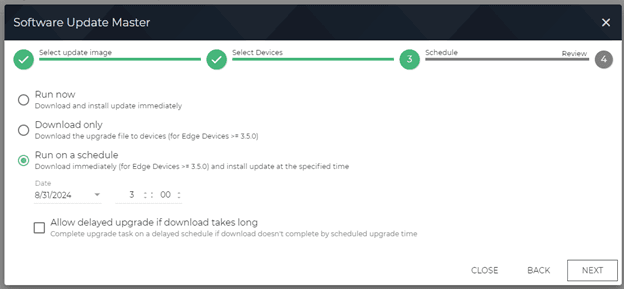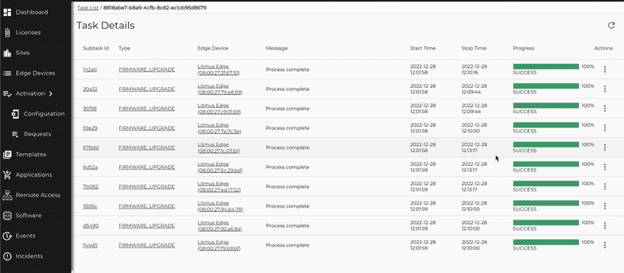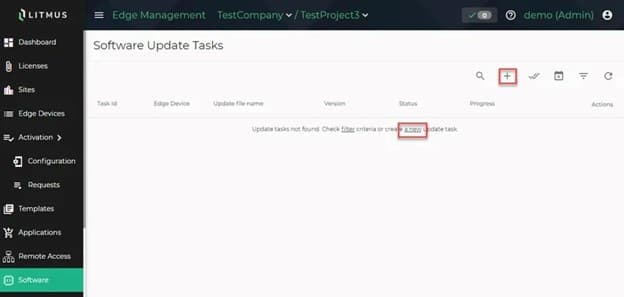Vishvesh Shah
Director of Product Management
The integration of edge computing with digital twins can help address challenges faced by manufacturers. It can reduce response time, optimize data, improve security, and lower risk.
Achieve seamless and secure remote software management for IIoT devices. Learn how Litmus Edge Manager simplifies OTA updates for IIoT devices with secure, centralized, and automated software distribution.

Imagine managing software updates for thousands of devices spread across multiple sites, all without the need for physical visits. This is the power of over-the-air (OTA) updates with Litmus Edge Manager (LEM).
In this article, Vishvesh Shah, Director of Product Management at Litmus, delves into the unique challenges faced by industrial IoT (IIoT) environments, the innovative solutions provided by Litmus's OTA feature, and how you can start taking advantage today.
To fully appreciate the benefits of OTA updates, let's first explore the specific challenges they address in IIoT environments.
Multi-site industrial enterprises often encounter problems that OTA updates address directly. These include scalability, security, operational downtime, and skills gaps. Let’s take a closer look at each:
Scalability and Efficient Management: Manually updating software on numerous IIoT devices globally is time-consuming and prone to errors. OTA updates streamline this process, allowing simultaneous updates to many devices from a central location using LEM. LEM allows easy hosting of update files through the admin panel.
Security Vulnerabilities: IIoT devices in critical infrastructure require timely security patches and CVE fixes. OTA updates enable swift distribution of these patches, mitigating security concerns.
Operational Downtime: Scheduling updates during plant downtime minimizes disruptions. Features like A/B updates allow testing on a subset of devices before full deployment, ensuring stability before wide-scale implementation.
Skills Gap: OTA updates reduce the need for specialized on-site skills, ensuring consistent software versions across devices without requiring physical access.
These factors highlight why OTA updates are indispensable for managing large-scale IIoT deployments, leading us now into the broader value proposition of enabling OTA updates using LEM.
LEM empowers users to seamlessly manage their IIoT devices by addressing critical challenges, thereby maximizing the effectiveness of OTA updates and enhancing overall operational efficiency. LEM’s OTA update feature offers a secure, reliable, and efficient solution for managing software updates across IIoT devices. This allows users to:
Upgrade Devices: Leverage new features like driver support, integration capabilities, or new data analytic algorithms.
Resolve Critical Bugs: Efficiently fix issues across all devices.
Run Upgrades Efficiently: Manage updates on single devices, groups, or all devices across multiple sites in one operation.
Maintain Full Control: Remotely control software versions, with built-in retries to handle network interruptions.
Ensure Security: Conduct updates over encrypted connections, protecting against impersonation or man-in-the-middle attacks. Devices verify the integrity and authenticity of updates to prevent corruption.
Examining how customers utilize OTA updates can provide deeper insights into their practical benefits. Our customers typically use OTA updates for:
Targeted Updates: Using the Litmus Edge Manager (LEM) user interface, customers can select specific edge devices within different companies or projects to apply updates.
Scheduled Updates: Customers often schedule OTA updates to occur during planned maintenance windows or periods of low activity, minimizing the impact on their operations.

Security and Compliance: Consistently applying Litmus Edge updates helps customers maintain compliance with industry regulations and internal security policies.
Monitoring and Reporting: Using LEM, customers can track the status of updates, ensuring that all targeted devices have received and successfully applied the updates.

OTA updates are particularly beneficial in industries such as manufacturing, energy and utilities, transportation, healthcare, and agriculture.
In manufacturing, OTA updates ensure machinery operates with the latest software, reducing downtime and enhancing efficiency. In energy and utilities, they help maintain compliance and prevent failures by quickly deploying necessary patches across widespread equipment. For transportation, OTA updates keep fleets and transit systems running smoothly, updating navigation, safety features, and communication protocols. In healthcare, they ensure medical devices and systems are updated promptly, improving functionality and patient outcomes. In agriculture, OTA updates optimize smart farming equipment, enhancing efficiency and yields.
These examples across various industries highlight the wide-ranging applications and significant benefits of OTA updates.
If you are keen to delve deeper into the technical details of OTA updates using Litmus Edge Manager, two essential resources on the Litmus website provide comprehensive guidance. These sources cover different aspects of the update process, offering detailed instructions and broader insights.

This guide provides a thorough explanation of how to set up and manage software update tasks for edge devices using Litmus Edge Manager. Key highlights include:
Ensuring necessary update files are available, devices are online, and no current update tasks are running.
Step-by-step instructions on creating a software update task by selecting software packages, targeting specific edge devices, and scheduling updates with options for immediate execution, download-only, or scheduled updates. It also includes handling delayed upgrades if the download is not completed on time.
Monitoring the progress of updates with automatic refreshes and progress bars, managing task completion, and handling timeouts and disconnections. Successful updates are moved to the history tab, while failures are flagged for review.
This source is ideal for users who need detailed procedural steps and insights into managing multiple tasks efficiently.

This resource focuses on the comprehensive capabilities of the Edge Software module within the Litmus Edge Manager. It includes:
Instructions for uploading .upd files to the admin console via file uploads or signed URLs, with examples provided.
Guidance on creating device groups for updates and scheduling these updates to ensure devices run the latest software versions. It also covers managing disk space and viewing update history.
Troubleshooting solutions for common issues, such as Firefox upload errors due to certificate problems, with steps to accept self-signed certificates and ensure smooth uploads.
This guide is particularly beneficial if you need to understand the module's broader functionalities, including managing software images and troubleshooting, ensuring devices are consistently updated and running efficiently.
So, there you have it. My take on OTA updates, and I hope it was useful! By centralizing and automating the update process, LEM addresses security, efficiency, and – most importantly – scaling challenges head on. This makes OTA updates a must-have for industrial enterprises with multiple sites, enabling them to maintain compliance and operational efficiency no matter where they are in the world.
If you're interested in learning more about how LEM can optimize your IIoT device management, reach out to our team today!
Industrial DataOps is a journey, and we’re here for you every step of the way!
Vishvesh Shah
Director of Product Management
Vishvesh Shah heads the Research and Development efforts at Litmus.
Vishvesh Shah
Director of Product Management
The integration of edge computing with digital twins can help address challenges faced by manufacturers. It can reduce response time, optimize data, improve security, and lower risk.
David Buck
VP Sales, Litmus
Crucial for capturing business value from data for driving real-time decisions. Success requires more than unlocking data; it needs effective centralized management and scalability across all plants in the organization.
Suranjeeta Choudhury
Director of Product Marketing
SCADA and other Systems of Records (SOR) like MES, Historian, ERP, CRM, or time-series databases have served their time as the pillars of Industry 3.0. However, the dawn of Industry 4.0 brings forth a seismic shift.